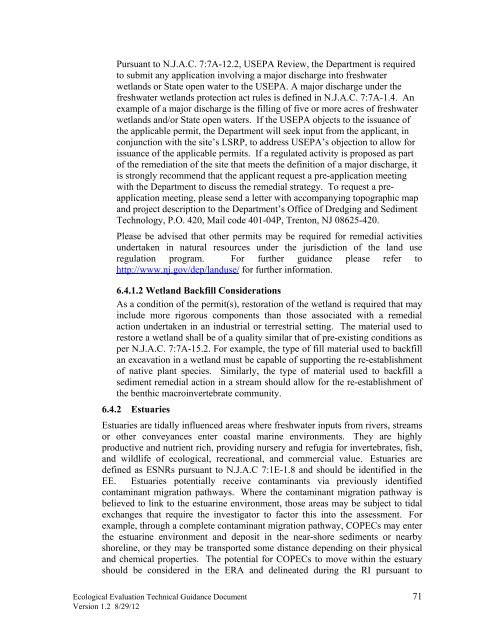Ecological Evaluation Technical Guidance - State of New Jersey
Ecological Evaluation Technical Guidance - State of New Jersey
Ecological Evaluation Technical Guidance - State of New Jersey
- No tags were found...
You also want an ePaper? Increase the reach of your titles
YUMPU automatically turns print PDFs into web optimized ePapers that Google loves.
Pursuant to N.J.A.C. 7:7A-12.2, USEPA Review, the Department is requiredto submit any application involving a major discharge into freshwaterwetlands or <strong>State</strong> open water to the USEPA. A major discharge under thefreshwater wetlands protection act rules is defined in N.J.A.C. 7:7A-1.4. Anexample <strong>of</strong> a major discharge is the filling <strong>of</strong> five or more acres <strong>of</strong> freshwaterwetlands and/or <strong>State</strong> open waters. If the USEPA objects to the issuance <strong>of</strong>the applicable permit, the Department will seek input from the applicant, inconjunction with the site’s LSRP, to address USEPA’s objection to allow forissuance <strong>of</strong> the applicable permits. If a regulated activity is proposed as part<strong>of</strong> the remediation <strong>of</strong> the site that meets the definition <strong>of</strong> a major discharge, itis strongly recommend that the applicant request a pre-application meetingwith the Department to discuss the remedial strategy. To request a preapplicationmeeting, please send a letter with accompanying topographic mapand project description to the Department’s Office <strong>of</strong> Dredging and SedimentTechnology, P.O. 420, Mail code 401-04P, Trenton, NJ 08625-420.Please be advised that other permits may be required for remedial activitiesundertaken in natural resources under the jurisdiction <strong>of</strong> the land useregulation program. For further guidance please refer tohttp://www.nj.gov/dep/landuse/ for further information.6.4.1.2 Wetland Backfill ConsiderationsAs a condition <strong>of</strong> the permit(s), restoration <strong>of</strong> the wetland is required that mayinclude more rigorous components than those associated with a remedialaction undertaken in an industrial or terrestrial setting. The material used torestore a wetland shall be <strong>of</strong> a quality similar that <strong>of</strong> pre-existing conditions asper N.J.A.C. 7:7A-15.2. For example, the type <strong>of</strong> fill material used to backfillan excavation in a wetland must be capable <strong>of</strong> supporting the re-establishment<strong>of</strong> native plant species. Similarly, the type <strong>of</strong> material used to backfill asediment remedial action in a stream should allow for the re-establishment <strong>of</strong>the benthic macroinvertebrate community.6.4.2 EstuariesEstuaries are tidally influenced areas where freshwater inputs from rivers, streamsor other conveyances enter coastal marine environments. They are highlyproductive and nutrient rich, providing nursery and refugia for invertebrates, fish,and wildlife <strong>of</strong> ecological, recreational, and commercial value. Estuaries aredefined as ESNRs pursuant to N.J.A.C 7:1E-1.8 and should be identified in theEE. Estuaries potentially receive contaminants via previously identifiedcontaminant migration pathways. Where the contaminant migration pathway isbelieved to link to the estuarine environment, those areas may be subject to tidalexchanges that require the investigator to factor this into the assessment. Forexample, through a complete contaminant migration pathway, COPECs may enterthe estuarine environment and deposit in the near-shore sediments or nearbyshoreline, or they may be transported some distance depending on their physicaland chemical properties. The potential for COPECs to move within the estuaryshould be considered in the ERA and delineated during the RI pursuant to<strong>Ecological</strong> <strong>Evaluation</strong> <strong>Technical</strong> <strong>Guidance</strong> Document 71Version 1.2 8/29/12
















